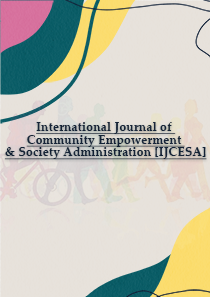International Journal of Community Empowerment & Society Administration [IJCESA]
Citation :
Dharani K, Shobana R, 2025. "Digital Storytelling and Cultural Memory: Reimagining the Humanities in the Age of Artificial Intelligence Abstraction" International Journal of Community Empowerment & Society Administration [IJCESA] Volume 2, Issue 1: 16-27.
Abstract :
Within the humanities, there has traditionally been an interest in the relationship between technical developments and cultural memory and storytelling. Digital storytelling has transformed how we, as individuals and communities, share our memories through multimodal environments that weave voice, image, text and interactivity in complex ways over the past couple decades. Artificial intelligence has been progressing in leaps and bounds, presenting both opportunities and challenges for the creation, archiving, and understanding of stories. In the context of artificial intelligence, this article interrogates the intersections between digital storytelling and cultural memory, arguing that these technologies are both expanding humanities praxis and raising ethical, epistemic, and curatorial challenges. Digital storytelling is generally accepted as a collaborative process of people/organizations making short, narrative based movies together, often with the aid of some form of digital technology. Many of these stories are drawn from personal experience, and have been taken up as means to promote civic engagement, increase the visibility of marginalized populations, or establish accessible repositories for collective memory. But cultural memory theory, as articulated by thinkers like Jan Assmann and Pierre Nora, insists that institutional, ritualistic, and material “sites of memory” help animate identity over time. And that relationship is gaining newfound potency due to the integration of digital storytelling and AI, making it possible for us to process, scale, and recycle stories in ways previously unimaginable. On the one hand, generative models allow new types of interactive storytelling and personalized stories; on the other hand technologies like automated transcription, metadata generation, and image recognition make archives more accessible.The very affordances are also -obviously- poses some serious dangers. By relying on substandard training data, mistakes in the process of recognition, or overly artificial narrative construction, AI can end up confusing or "overwriting" cultural memory. Real testimony becomes indistinct from fake narrative when AI authors or modifies tale pieces, which prompts us to question provenance and credibility. What’s more, the use of AI for cultural heritage organizations presents governance issues including who decides which memories matter most, how stories are treated and how localities can retain control over their narratives. The role of AI in memory work is also further complicated by the potential for commercialization and data harvesting – especially when hosted, curated or produced on commercial platforms. This research demonstrates the opportunities and limitations of AI-digital trust initiatives for cultural memory institutions, taking examples from StoryCorps and Europeana/AI4Culture. StoryCorps demonstrates how digital technology can facilitate the expansion of a community-based storytelling enterprise, but also illustrates how to control automation in order to keep it personal and authentic. The success of Europeana and AI4Culture in showing how AI can contribute to the preservation of rich institutional infrastructures with open standards and community building. Together, these cases emphasize that AI is not neutral: it reorganizes cultural authority, what and who is remembered and what counts as a story.As this study suggests, recasting the humanities in AI’s image requires maintaining an important proportion of provision and transparency&inclusivity values while taking advantage of AI–s potential to democratize access and enhance story-telling opportunities. Ultimately, AI should be understood as a technology that needs to be critically mediated by humanists, communities and cultural organisations rather than replacing the role of humans as storytellers and curators. By generating design principles and governance bodies, the humanities can ensure that digital storytelling remains a lively place of cultural memory, enriched rather than diminished by AI.
References :
[1] StoryCorps. (n.d.). About StoryCorps. Retrieved from https://storycorps.org/about/
[2] StoryCorps. (2024, June 13). Inside StoryCorps: The Role of Data in Storytelling. Retrieved from https://storycorps.org/inside-storycorps-the-role-of-data-in-storytelling/
[3] Europeana. (2025, May 12). AI4Culture platform. Retrieved from https://pro.europeana.eu/page/ai4culture-platform
[4] Europeana. (2024, October 4). Launching the AI4Culture Platform: Empowering Cultural Heritage with AI Tools and Resources. Retrieved from https://pro.europeana.eu/post/launching-the-ai4culture-platform-empowering-cultural-heritage-with-ai-tools-and-resources
[5] Foka, A. (2025). AI, cultural heritage and bias-mitigating in practice. SpringerLink. https://link.springer.com/article/10.1007/s00146-025-02349-z
[6] Foka, A. (2024). AI, Cultural Heritage, and Bias: Some Key Queries That Need Attention. MDPI. https://www.mdpi.com/2571-9408/7/11/287
[7] Winters, J. (2024, October 21). AI Meets Archives: The Future of Machine Learning in Cultural Heritage. CLIR. https://www.clir.org/2024/10/ai-meets-archives-the-future-of-machine-learning-in-cultural-heritage/
[8] Chung, N. C. (2021). Human in the Loop for Machine Creativity. HCOMP 2021. https://www.humancomputation.com/2021/assets/blue_sky/HCOMP_2021_paper_101.pdf
[9] Breemen, V. (2025). 'Slow libraries' and 'Cultural AI'. TechReg. https://techreg.org/article/view/19595
[10] Chung, N. C. (2021). Human in the Loop for Machine Creativity. HCOMP 2021. https://www.humancomputation.com/2021/assets/blue_sky/HCOMP_2021_paper_101.pdf
[11] UNESCO. (n.d.). Ethics of Artificial Intelligence. Retrieved from https://www.unesco.org/en/artificial-intelligence/recommendation-ethics
[12] Thomas, S. (2024). AI and Actors: Ethical Challenges, Cultural Narratives and Representation. SAGE Journals. https://journals.sagepub.com/doi/full/10.1177/27523543241289108
[13] Vanallemeersch, T. (2024). Towards Multilingual Access for Cultural Heritage Data. ACL Anthology. https://aclanthology.org/2024.eamt-2.30/
[14] Ghaith, K. (2024). A Qualitative Study on the Integration of Artificial Intelligence in Cultural Heritage Institutions. Lindenwood University. https://digitalcommons.lindenwood.edu/cgi/viewcontent.cgi?article=1663&context=faculty-research-papers
[15] Dwi, M. (2025). Ethical and Psychological Implications of Generative AI in Cultural Memory Preservation. ScienceDirect. https://www.sciencedirect.com/science/article/pii/S2666659625000320
[16] StoryCorps. (n.d.). Discover StoryCorps. Retrieved from https://storycorps.org/discover/
[17] StoryCorps. (n.d.). StoryCorps Connect. Retrieved from https://storycorps.org/participate/storycorps-connect/
[18] ViduraAI. (2024). Leveraging AI to Revolutionize Oral History Preservation. Medium. https://medium.com/@ViduraAI/leveraging-ai-to-revolutionize-oral-history-preservation-95cc104270e3
[19] Weinberg, M. (2025). Are AI Bots Knocking Cultural Heritage Offline?. Gamelab. https://glamelab.org/products/are-ai-bots-knocking-cultural-heritage-offline/
[20] Menlibayeva, A. (2025). The Photographer Using AI to Reconstruct Stories Lost to Censorship. The Verge. https://www.theverge.com/ai-artificial-intelligence/688648/almagul-menlibayeva-ai-reimagining-censored-government-work
Keywords :
Digital Storytelling; Cultural Memory; Artificial Intelligence; Digital Humanities; Generative AI; Storycorps; Europeana; AI4Culture; Oral History; Archives; Provenance; Ethics Of AI; Human-In-The-Loop; Community Governance; Memory Studies; Multimodal Narratives; Cultural Heritage Preservation.


